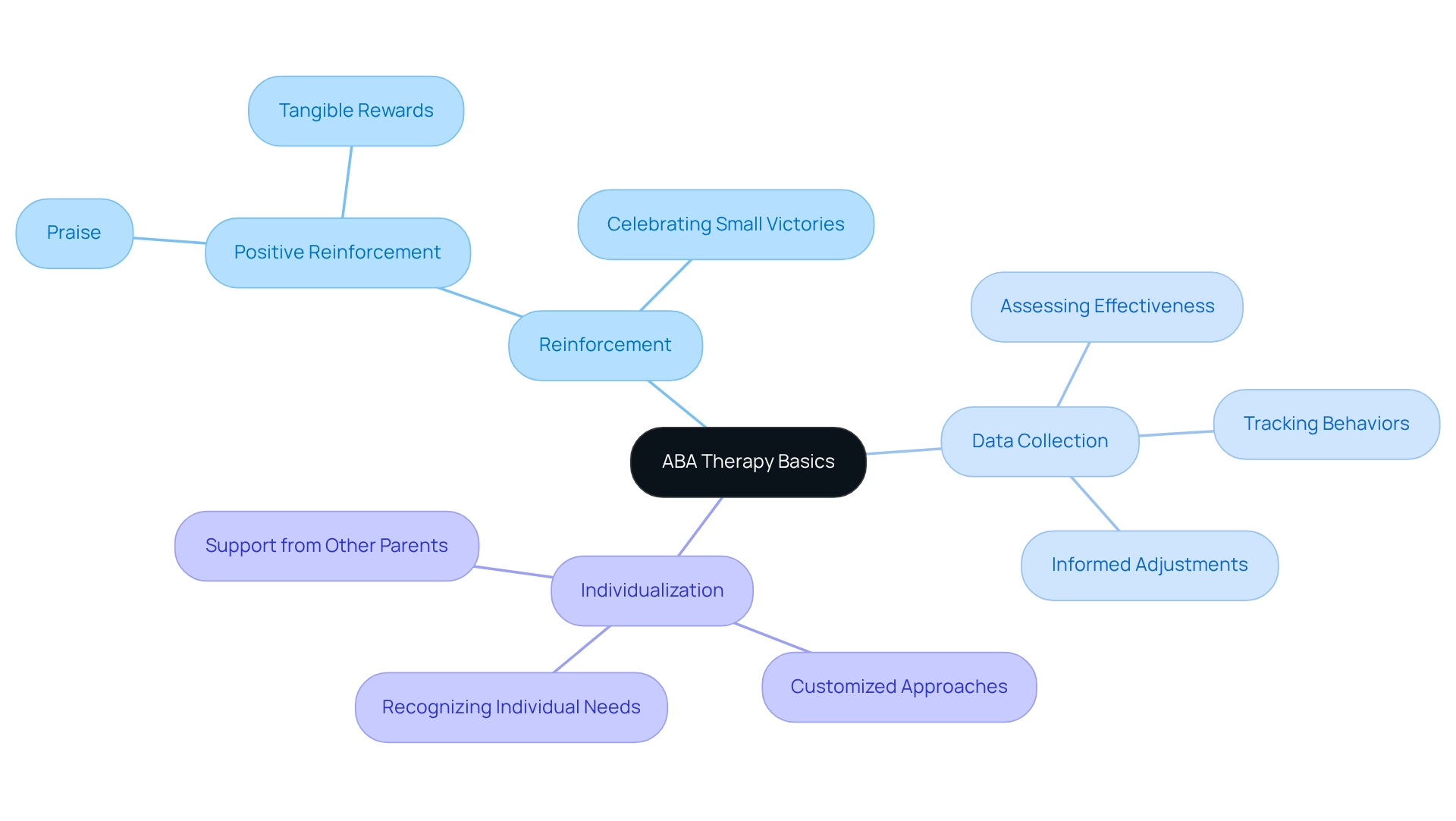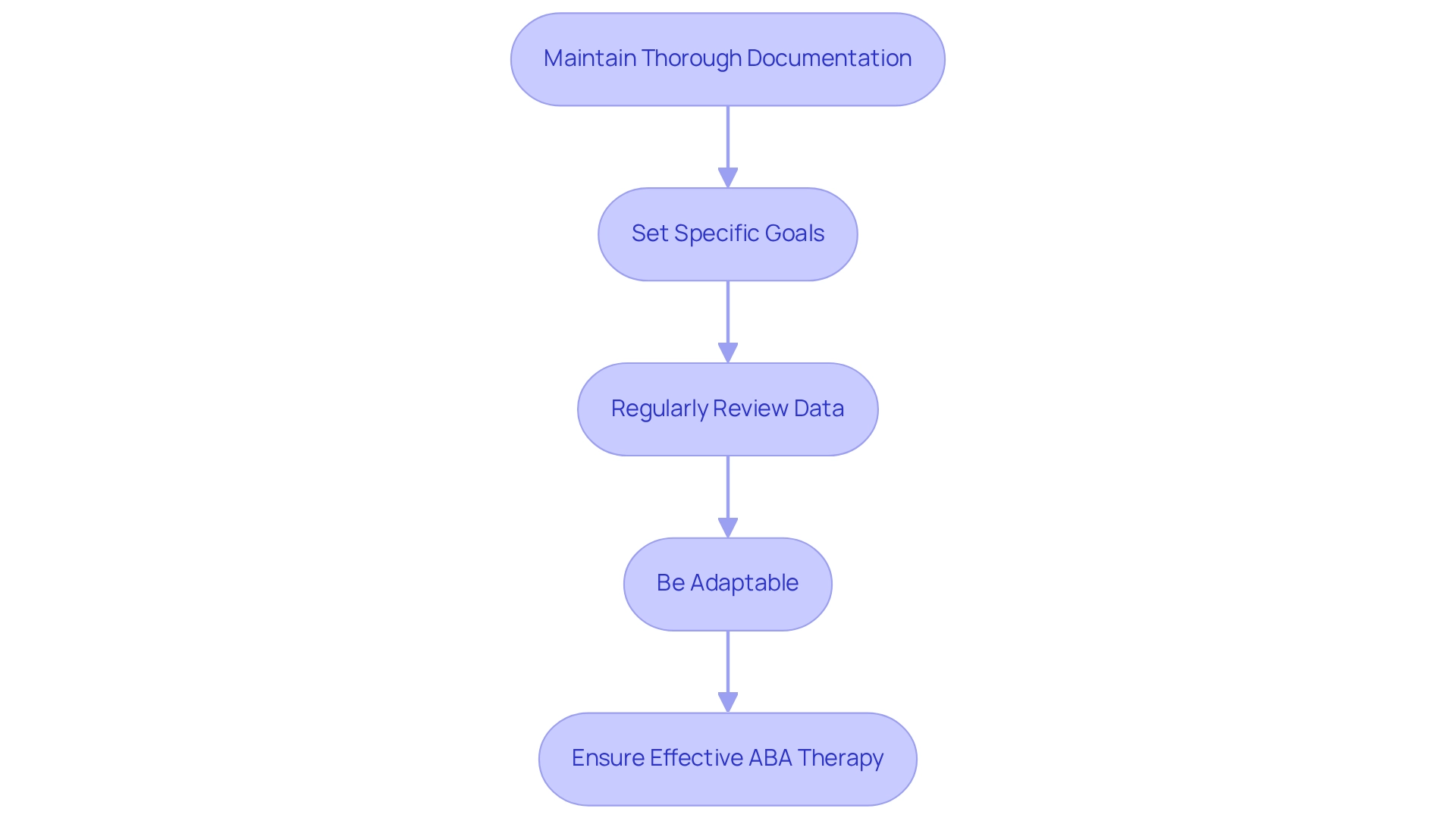Overview
Implementing ABA therapy at home can be a rewarding journey for both you and your child. To begin, focus on four essential steps:
- Understanding the principles of ABA
- Preparing your home environment
- Incorporating ABA techniques into daily routines
- Monitoring progress to adjust strategies as needed
This approach not only supports your child’s development but also fosters a nurturing atmosphere.
Creating a designated therapy space is a wonderful first step. This space should be free from distractions, allowing your child to engage fully in their therapy. Utilizing positive reinforcement is another key technique. Celebrate small victories, as these moments can significantly boost your child’s motivation and confidence.
Maintaining thorough documentation is crucial. By keeping track of your child’s progress, you can identify what works best and make necessary adjustments. Remember, this journey is not just about techniques; it’s about building a supportive environment where your child feels safe and encouraged to grow.
As you embark on this path, know that you are not alone. Many parents share similar experiences and challenges. Consider reaching out to others in your community or online forums to exchange ideas and support. Together, we can create a brighter future for our children.
Introduction
Navigating the world of Applied Behavior Analysis (ABA) therapy can be both rewarding and challenging for parents and caregivers. This therapeutic approach is designed to enhance the learning and development of children by modifying behaviors through structured techniques. As you embark on this journey, understanding the foundational principles of ABA is essential. Preparing a conducive home environment and effectively integrating these strategies into daily routines are crucial steps in fostering a supportive atmosphere for growth.
By actively monitoring progress and remaining open to adjustments, caregivers can ensure that their child receives the most effective and personalized support possible. Remember, you are not alone in this process; many parents share similar experiences and challenges. Embrace the journey, and together, we can create a nurturing environment that fosters your child's development.
Understand ABA Therapy Basics
Applied Behavior Analysis (ABA) is a therapeutic approach that focuses on understanding and modifying behavior through systematic techniques. It’s important to grasp some key principles that can help you support your child effectively.
-
Reinforcement: This involves providing rewards to encourage desired behaviors. Think of it as a way to celebrate small victories! Positive reinforcement, such as praise or tangible rewards, is particularly effective in motivating children to engage in positive actions.
-
Data Collection: Tracking behaviors and progress is essential for assessing the effectiveness of interventions. By keeping a record, you can see what works and what doesn’t, allowing you to make informed adjustments to your strategies.
-
Individualization: ABA is customized to address the unique needs of each young person, considering their specific challenges and strengths. Every child is different, and recognizing their individuality is key to helping them thrive, especially when implementing ABA therapy in home. Remember, you’re not alone in this journey—many parents are navigating similar challenges, and sharing your experiences can provide valuable support for one another.

Prepare Your Home for ABA Therapy
Preparing your home for ABA therapy in-home is an important step in supporting your child's development. By following these thoughtful steps, you can create a nurturing environment that fosters learning and growth with ABA therapy in-home.
- Designate a Therapy Space: Choose a quiet, well-lit area that is free from distractions. This space should be comfortable and equipped with the necessary materials to make your child feel at ease.
- Organize Materials: Collect toys, visual aids, and other resources that align with your child's treatment objectives. Keeping these materials easily accessible will help facilitate learning during therapy sessions.
- Establish a Routine: Consistency is essential in ABA practice. Establish a daily timetable that incorporates designated times for counseling sessions, play, and additional activities to help your child feel secure and focused.
- Minimize Distractions: Limit noise and visual distractions in the therapy area. Consider using calming colors and soft lighting to create a focused environment that promotes concentration.
By following these steps, you will create an environment that not only supports your child's learning but also nurtures their emotional well-being.

Implement ABA Techniques in Daily Routines
To effectively implement ABA therapy in home daily routines, consider these nurturing strategies that can make a difference:
- Use Visual Schedules: Creating a visual representation of daily activities can help your little one understand what to expect. This simple tool can significantly reduce anxiety and improve compliance.
- Incorporate Reinforcement: Positive reinforcement during daily tasks is essential. For instance, when your child finishes chores or follows instructions, take a moment to commend them for their efforts. This encouragement can motivate them further.
- Model Desired Behaviors: Children often learn by watching. If you want your child to share toys, demonstrate sharing during playtime. Your actions can speak volumes and guide them toward the behaviors you wish to encourage.
- Practice Consistency: It's crucial that all caregivers are aligned in implementing ABA techniques. Consistency across different environments reinforces learning and helps your child feel secure in their routines, particularly with ABA therapy in home settings.
By incorporating these techniques into everyday activities, you will be helping your child generalize the skills they acquire during therapy sessions. Remember, every small step you take contributes to their growth and development.

Monitor Progress and Adjust Strategies
To support your child's progress and adapt strategies effectively, consider these compassionate steps:
- Maintain Thorough Documentation: Keep a record of your child's behaviors, their responses to interventions, and any changes in their development. This information will be invaluable for assessing what works best for them.
- Set Specific Goals: Establish clear, measurable objectives for your child. This clarity will help you track their advancement and determine when adjustments are necessary.
- Regularly Review Data: Take time to analyze the collected information to identify patterns or areas that may need improvement. Share your observations with your ABA therapist to gain professional insights and support.
- Be Adaptable: Stay open to modifying strategies as your child develops. If a particular approach isn’t yielding the desired results, consult with your therapist to explore alternative techniques that may better suit your child's needs, particularly in the context of ABA therapy in home. By actively engaging in monitoring your child’s progress and being willing to adapt your strategies, you can ensure that the ABA therapy in home remains effective and responsive to their unique needs.

Conclusion
Understanding and implementing Applied Behavior Analysis (ABA) therapy can significantly enhance a child's learning and development. By familiarizing oneself with the foundational principles of ABA—such as reinforcement, data collection, and individualization—caregivers can establish a strong groundwork for their child's progress.
Creating a supportive home environment tailored to ABA therapy involves:
- Designating a focused therapy space
- Organizing necessary materials
- Establishing routines
- Minimizing distractions
These steps foster an atmosphere conducive to learning and growth. Moreover, integrating ABA techniques into daily routines—through visual schedules, positive reinforcement, and modeling desired behaviors—ensures that learning extends beyond therapy sessions and becomes part of everyday life.
Monitoring progress is equally vital. Keeping detailed records, setting specific goals, and regularly reviewing data allow caregivers to assess the effectiveness of interventions and make necessary adjustments. Flexibility in approach ensures that the therapy remains responsive to the child's evolving needs.
Overall, embracing the journey of ABA therapy, with its challenges and rewards, empowers caregivers to create a nurturing environment that supports their child's development. By remaining engaged, informed, and adaptable, caregivers can profoundly impact their child's learning journey. We encourage you to share your experiences and insights, as together we can support one another in this important endeavor.
Frequently Asked Questions
What is Applied Behavior Analysis (ABA)?
Applied Behavior Analysis (ABA) is a therapeutic approach that focuses on understanding and modifying behavior through systematic techniques.
What is the role of reinforcement in ABA?
Reinforcement involves providing rewards to encourage desired behaviors. Positive reinforcement, such as praise or tangible rewards, is particularly effective in motivating children to engage in positive actions.
Why is data collection important in ABA?
Data collection is essential for tracking behaviors and progress, allowing caregivers to assess the effectiveness of interventions and make informed adjustments to their strategies.
How is ABA individualized for each child?
ABA is customized to address the unique needs of each child, considering their specific challenges and strengths. Recognizing each child's individuality is key to helping them thrive during ABA therapy.
How can parents find support while implementing ABA therapy?
Parents can find support by sharing their experiences with others who are navigating similar challenges, as many parents face comparable situations when implementing ABA therapy at home.




